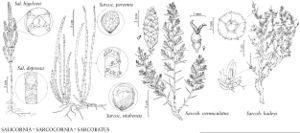Salicornia bigelovii
in W. H. Emory, Rep. U.S. Mex. Bound. 2(1): 184. 1859.
Stems erect, green sometimes becoming red, simple or with primary and secondary branches, 5–60 cm, ultimate branches short or long; leaf and bract apices acute, sharply mucronate. Spikes cylindric and slightly torulose, 2–10 cm, with 5–25 fertile segments; bracts almost obscuring cymes. Fertile segments 4–5 × 4.5–6.2 mm, wider than long, widest distally, margins ca. 0.5 mm wide, scarious. Central flower semicircular distally, 2.2–2.8 × 2–2.8 mm, about as long as wide, usually reaching top of segment, only slightly larger than lateral flowers; anthers exserted, dehiscing after exsertion. 2n = 36.
Phenology: Flowering late summer–early fall, year-round in Fla.
Habitat: Middle levels of saltmarshes
Elevation: 0-100 m
Distribution

Calif., Fla., Ga., Maine, Md., Mass., N.J., N.Y., N.C., S.C., Tex., Va., n Mexico (Caribbean and Pacific coasts)
Discussion
Salicornia bigelovii probably also occurs in Alabama, Mississippi, and Louisiana, but no specimens have been seen that confirm its presence in these states.
Selected References
None.
Lower Taxa
No values specified.No values specified.
